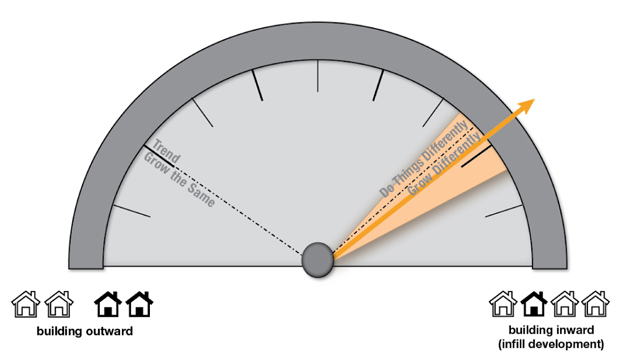Think Big: Public Engagement

 Sasaki
Sasaki

Scenario planning is an important part of thinking about the future of a region. Using certain data sets and GIS modeling, planners test potential outcomes of alternative future development patterns, transportation systems, and open space networks. This highly technical process helps us answer the question: What are the impacts—fiscally, socially, environmentally, personally—if we take certain courses of action? It leaves the question: What should we do?
This second question is where public engagement comes in. Scenario planning can help quantify impacts and reveal tradeoffs, but data cannot make decisions by itself. Planners play a key role in helping community members participate meaningfully in conversations about the future. But creating a captive audience, communicating rather esoteric information, and getting people to think far beyond the here-and-now can be some of the most complex aspects of scenario planning.
In Northeast Ohio as part of the Vibrant NEO 2040 initiative, we undertook a robust scenario planning process. When it came to public engagement, we used the following tenets to guide us:
Current policies and funding priorities have contributed to an outward migration of people away from the region’s central cities and established towns. A key question facing the region is whether policies should shift in the future. Should the region continue to develop outward, or should it prioritize reinvestment in existing communities? Previous blog posts have explored the technical process of modeling outward migration and quantifying the impacts of sprawl. Through the public engagement process, we asked important questions to understand how the public viewed these issues.
To understand the public’s preferred vision for the future of Northeast Ohio, we developed two engagement strategies.

The first was a workshop at which we presented a Trend Scenario, which illustrated what the region might be like in 2040 if current conditions continued. Attendees then worked in groups to create maps of their desired futures. Using game pieces, participants indicated their desired mix of development—and where they wanted open space or transportation improvements.
Why it works: Group work gets people to discuss and negotiate tradeoffs, and is also an open-ended process. By using game pieces that, at scale, represented the actual size for development, we were able to help people see that compact growth takes up less space, and enables the preservation of open space. The number of game pieces reflected the quantity of projected growth, which helped groups see how much undeveloped land would be developed if current trends continued. Using maps helped us understand what type of development people want to see in different parts of the region and how people feel about the current trends in the region.

Click the thumbnail to the right to view the composite feedback from the workshops
Our team then digitized all the maps and overlaid results to create a composite public vision. The “Do Things Differently” & “Grow Differently” scenarios reflected the desires of the majority of participants, which included reinvesting in legacy communities, protecting natural and agricultural resources, and balancing auto-oriented development with communities that support walking, biking, and public transportation. The “Grow the Same” scenario incorporated the views of a minority of participants: dispersed development should be maximized across the region.

The second strategy was to hold open houses across the region. After a video introducing the key issues and scenarios, participants visited stations that focused on key questions. For instance, the “outward migration” station asked participants how future investments in the region should be allocated: should we develop inward or outward? Feedback cards featured a dial that displayed the two extreme positions of a choice—and the spectrum between. Participants sketched their opinion on the dial and were also able to write additional comments. An overall survey at the end asked participants to think holistically about the scenarios. Rather than voting on a particular scenario, the cards at this station were designed to draw out more detailed feedback.
We asked specific questions, rather than open-ended prompts (e.g., “Tell us what you think!”). Regional planning isn’t something people think about every day, so they need a little bit of education, an unbiased presentation of options, and opportunities for a two-way conversation in everyday language.
Why it works: We presented information in accessible language with an information hierarchy designed to appeal to different learning styles. The combination of dial plus open-ended comments allowed us to quantitatively understand overall opinions as well as why participants felt like they did. By asking questions about the scenarios rather than wholesale voting, we were able to understand the shades of grey in the public’s opinion, and what in particular they liked or disliked about a given scenario.

Community investment feedback card

Overall average across all regional responses (arrow) and range of averages from all open house locations (wedge)
Community investment feedback card
Overall average across all regional responses (arrow) and range of averages from all open house locations (wedge)
The results from the open houses directly shaped the preferred regional vision, which focused on reinvestment in existing communities, expanding transportation options, and preserving and protecting natural resources and agricultural land.
After synthesizing all the input we gained through public engagement in Northeast Ohio, it was clear that people supported doing things differently. This input directly influenced our recommendations in the regional vision that was adopted in February.
Changing direction can be difficult because of politics and many other factors—but being able to show that majority of public supports a new course of action is critical to enacting change.